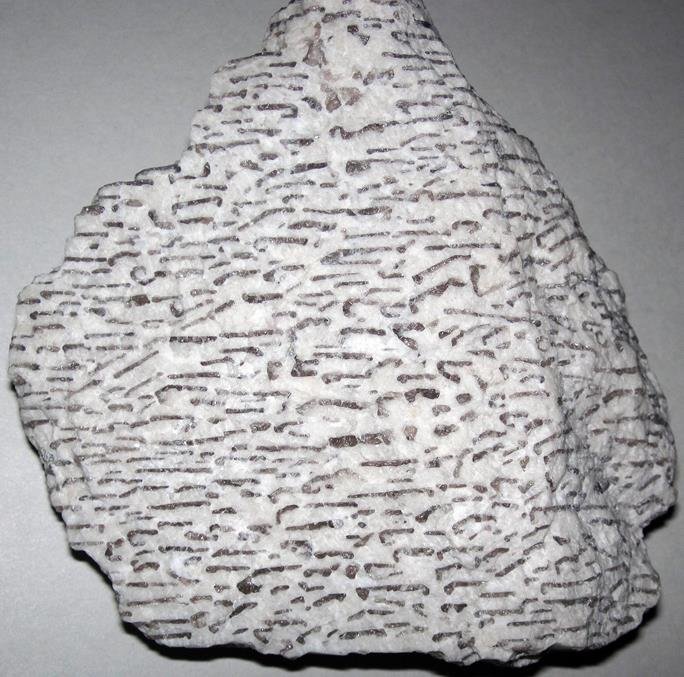Graphic texture refers to an intimate intergrowth of quartz in alkali feldspar visible by an aided eye.
This texture is common in granite rocks and pegmatites, with granites having this texture called graphic granites.
Graphic texture usually has large alkali feldspar crystals that will enclose a small volume of nearly uniform or parallel angular, rod-like quartz crystals, creating an appearance resembling hieroglyphic, runic, or cuneiform script or writings.
The embedded thin blends of quartz crystals will appear darker on a lighter background of alkali feldspar. Their crystallographic orientation seems controlled.
On the other hand, alkali feldspar will form large crystals, usually 2-10 cm in size or larger. Each will contain several of these angular, rodlike quartz crystals.
From a cross-section, the quartz appears like an ancient script on an alkali feldspar crystal background. However, when viewed from three dimensions, the quartz rods branch to form a single crystal of an irregular network of coral shape.
Since it resembles some ancient writings, rocks with graphic texture go by other names, like Hebrew stone, Hebraic pegmatite, corduroy rock, or graphic pegmatite.
Lastly, graphic texture occurs in other minerals besides intergrowth between quartz and alkali feldspar. However, such are rare.

Micrographic texture
When the graphic texture is only visible under a microscope, it is known as a micrographic texture. For instance, you can have micrographic granite.
It forms the same way as graphic texture. However, it only resolves under a microscope. A hand specimen will appear homogenous.
Composition
Rocks with graphic or micrographic texture are mostly acidic rocks. Acidic rocks are those with more than 65% silica.
These rocks are relatively high alkali feldspars, usually microcline, albite, and orthoclase, and have over 20% quartz.
Also, they have minerals like biotite and hornblende, among others, but in small quantities.
Lastly, their composition is more or less like granite.
How does graphic texture form?
Graphic texture forms when quartz and feldspar crystallize simultaneously. This crystallization happens in water-rich, residual (last portion) magma melts or under large amounts of aqueous vapor.
Usually, the intergrowth happens in granite eutectic. Eutectic means the melt is at a lower temperature than any constituents.
Considering the low amount of quartz, it is unlikely it forms from cotectic crystallization.
Cotectic means composition, temperature, and conditions at which two or more solid phases simultaneously crystallize from a homogenous solution. This occurs without resorption.
Lastly, experiments have produced quartz and feldspar intergrowth via replacement.
Similar intergrowth
Some intergrowths that resemble graphic textures are granophyric and myrketitic textures.
Granophyric intergrowth resembles micrographic texture. However, the intergrowths are less regular. They will have branching or feathery quartz rods inside feldspar crystals.
On the other hand, the myrketitic texture will result in wormy or vermicular quartz intergrowth in potassium plagioclase. It occurs at points where potassium plagioclase is in contact with potassium feldspar.
Also, it seems to occur from solid-state exsolution, mostly under deformation stress, not from simultaneous crystallization.
Lastly, feldspars can have intimate wormy or vermicular intergrowths with nepheline.
Uses
Graphic granite makes a wonderful decorative stone value over time, even before the Middle Ages. Also, it is cut to make cabochons and other decorative items.
